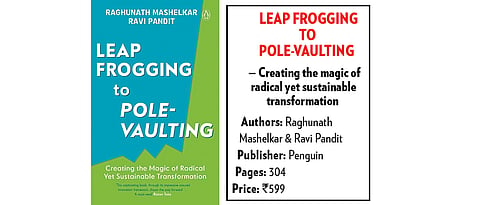

The challenges before today’s world are enormous and complex. Even the process of analysing them is a huge task, let alone finding their solutions. However, Raghunath Mashelkar and Ravi Pandit, global innovation leaders and authors of Leap Frogging to Pole-vaulting, have not only scientifically analysed the matter at hand but also given it a creative touch.
Their research is interspersed with data. The writer duo have woven their thesis around a formula of 3,4,7, which includes three global issues of energy, environment and employment, which they call 3 Es, 4 elements of STEP i.e. Society, Technology, Environment and Policy and 7 elements of ASSURED Innovation: Affordability, Scalability, Sustainability, Universality, Rapidity, Excellence and Distinctiveness. Their starting point is that a solution, an idea, an innovation, a project or an enterprise has to adhere to these parameters for its success.
The authors have made a difficult topic easy even for a layman to comprehend. They are of the view that these three issues of energy, environment and employment need ‘urgent action that can help make a radical yet sustainable transformation’.
As for the title of the book, ‘pole-vaulting’ as opposed to ‘leapfrogging’ indicates their reasoning: ‘Scientific studies show that frogs leap because they are afraid of predators’. They run to safety. It has negative connotations. However, pole-vaulting is much bigger and is an apt metaphor requiring one to ‘go over a bar’. When a pole-vaulter approaches the bar, the velocity is at its highest. ‘Rapid acceleration is the key, which can be achieved when the speed of thought matches the speed of action’. This is what ‘radical yet sustainable transformation’ means.
It needs to be underlined that Mashelkar and Pandit have not merely given a theoretical model. It is born out of their expertise and experience. Chapters 10 and 11 on ‘Solid waste management’ and ‘Transforming mobility’ prove this.
Each aspect of the 3,4,7 formula has been dealt with separately. While dealing with three Es, valuable facts are given such as: ...oil-producing countries on almost every continent have seen political tension and strife as a direct or indirect impact of their oil industries (pg 20). It is emphasised how the issues are interlinked and how it is essential to move away from fossil fuels to clean energy.
Elaborating on the environment in the three Es, a piece of information such as this is provided to highlight the gravity of the issue: ...non-biodegradable plastic in waters all around the world is likely to outweigh the fish in our oceans by 2059 (pg 25).
Following the dissection of the problems, the authors express optimism in the future technologies such as artificial intelligence, gene therapy, robotics and software, which have potential to solve these issues. Their inspiration is encapsulated in the traditional Indian prayer, which is given in the beginning of the book: Om sarve bhavantu sukhina, sarve santu niramaya meaning ‘may all be happy, may all be free from illness..’ It reminds one of John Stuart Mill’s Utilitarianism, which propagated ‘the greatest amount of good for the greatest number’.
The book has been appreciated by world leaders such as Ratan Tata, Nobel laureates Muhammad Yunus and Robert Grubbs, to name a few. It will be an interesting read for entrepreneurs, researchers, bureaucrats, politicians, technologists, teachers and students.
